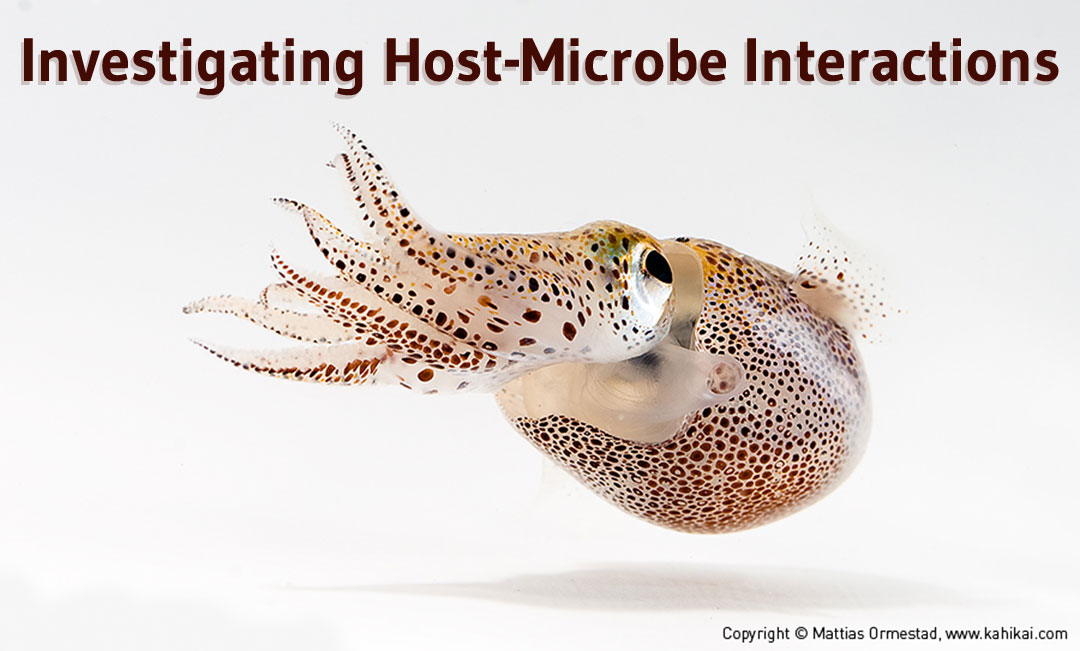
What we do
The goal of our laboratory is to understand the mechanisms by which animal hosts and microbial symbionts communicate with an emphasis on how components of the innate immune system may influence these interactions.
We use the symbiosis between the Hawaiian bobtail squid, Euprymna scolopes, and the bioluminescent bacterium, Vibrio fischeri, as a model system to study the effects of beneficial bacteria on animal host tissues. This association has an advantage in that each partner can be raised independently in the laboratory and is readily available for molecular, biochemical, and genetic analyses.
Recent Publications
Kerwin, A. H., Gromek, S. M., Suria, A. M., Samples, R. M., Deoss, D. J., O’Donnell, K., Frasca Jr., S., Sutton, D. A. Wiederhold, N. P., Balunas, M. J., Nyholm, S. V. (2019) Shielding the Next Generation: Symbtiontic Bacteria from a Reproductive Organ Protective Bobtail Squid Eggs from Fungal Fouling. mBio
Lynch, J. B., Schwartzman, J. A., Bennett, B. D., McAnulty, S. J., Knop, M. Nyholm, S. V., Ruby, E. G. (2019) Ambient pH Alters the Protein Content of Outer Membrane Vesicles, Driving Host Development in a Beneficial Symbiosis, Journal of Bacteriology
Baker, L. J., Freed, L. L., Easson, C. G., Lopez, J. V., Fenolio, D., Sutton, T. T., Nyholm, S. V., Hendry, T. A. (2019) Diverse deep-sea anglerfishes share a geneticall reduced luminous symbtion that is acquired from the environment. eLife
Rader, B., McAnulty S. J., Nyholm, S. V. (2019) Persistent symbiont colonization leads to a maturation of hemocyte response in the Euprymna sclolopes / Vibrio fischeri symbiosis. Microbiology Open
Belcaid, M., Casaburi, C., McAnulty M. J., Schmidbaur, H., Suria, A. M., Moriano-Gutierrez, S., Pankey, M. S., Oakley, T. H., Kremer, N., Koch, E.J., Collins, A. J., Nguyen, H., Lek, S., Goncharenko-Foster, I., Minx, P., Sodergren, E., Weinstock, G., Rokhsar, D., McFall-Ngai, M., Simakov, O., Foster, J. S., Nyholm, S. V. (2019) Symbiotic organs shaped by distinct modes of genome evolution in cephalopods. PNAS
Kerwin, A. H., Nyholm S. V., (2017). Symbiotic bacteria associated with a bobtail squid reproductive system are detectable in the environment, and stable in the host and in eggs throughout development. Environmental microbiology
McAnulty, S. J., Nyholm S. V., (2017) The Role of Hemocytes in the Hawaiian Bobtail squid, Euprymna scolopes: A Model Organism for Studying Beneficial Host-Microbe Interactions. Front. Microbiol.
Gromek, S. M., Suria A. M., Fullmer M.S., Garcia, J.L., Gogarten, J.P., Nyholm S. V., Balunas, M.J. (2016). Leisingera sp. JC1, a Bacterial isolate from Hawaiian Bobtail Squid Eggs, Produces Indigoidine and Differentially Inhibits Vibrios. Front. Microbiol.
Contact the Nyholm Lab
| Phone: | (860) 486 - 1883 |
|---|---|
| E-mail: | spencer.nyholm@uconn.edu |